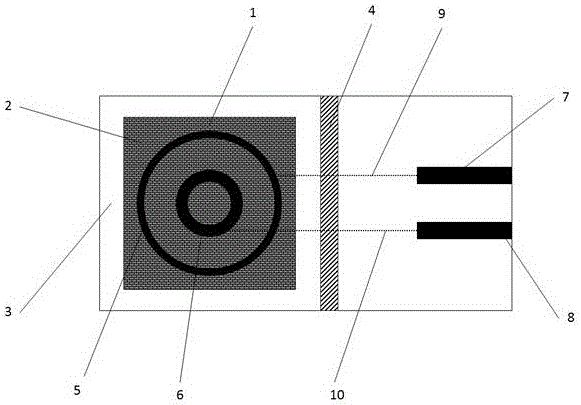Sensor for measuring salt content on surface of solid
A solid surface, sensor technology, applied in the direction of material impedance, etc., can solve the problems of high economic cost, high requirements for professional equipment and operators, and achieve the effect of realizing salt content and direct detection.
- Summary
- Abstract
- Description
- Claims
- Application Information
AI Technical Summary
Problems solved by technology
Method used
Image
Examples
Embodiment approach
[0018] As an embodiment of the present invention, the conductivity cell 3 includes wires and electrodes for measuring conductivity, the water-absorbing test paper 1 covers the electrodes of the conductivity cell, and the electrodes are connected to external conductivity measuring devices through wires. Each electrode can be connected to a gold finger of the external conductivity measuring device through a wire, and electrical connections between wires, electrodes, and gold fingers that do not have a connection relationship should be avoided to cause a short circuit. If the substrate of the conductivity cell 3 is made of flexible material and becomes a flexible circuit board (FPC), the sensor of the present invention can be used to measure the salt content on a curved surface. Preferably, the substrate of the conductivity cell 3 can be made of a double-sided flexible copper clad laminate.
[0019] As a preferred embodiment of the present invention, such as figure 1 and figur...
PUM
 Login to View More
Login to View More Abstract
Description
Claims
Application Information
 Login to View More
Login to View More - R&D
- Intellectual Property
- Life Sciences
- Materials
- Tech Scout
- Unparalleled Data Quality
- Higher Quality Content
- 60% Fewer Hallucinations
Browse by: Latest US Patents, China's latest patents, Technical Efficacy Thesaurus, Application Domain, Technology Topic, Popular Technical Reports.
© 2025 PatSnap. All rights reserved.Legal|Privacy policy|Modern Slavery Act Transparency Statement|Sitemap|About US| Contact US: help@patsnap.com


